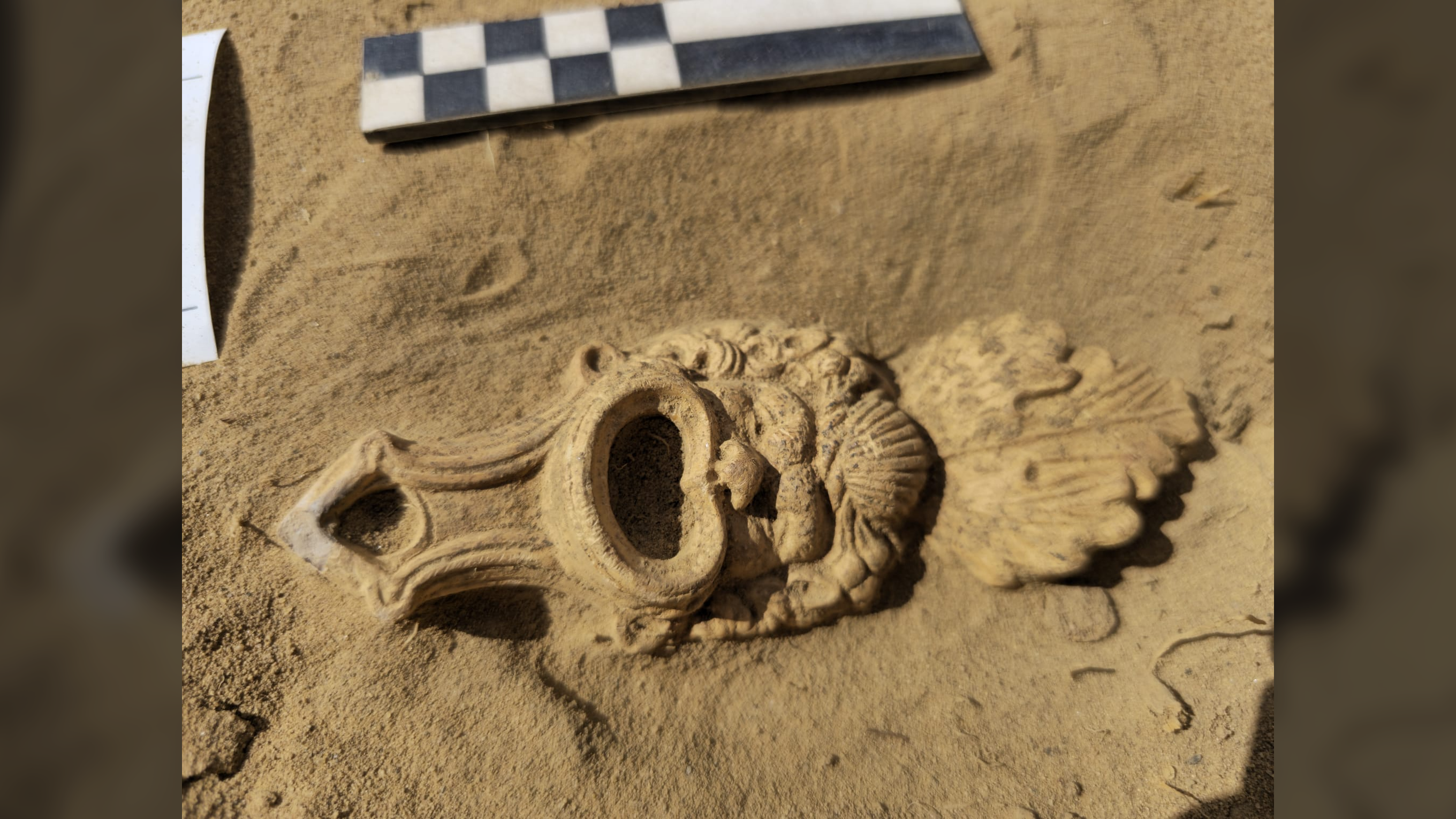1,900-year-old oil lamp that provided ‘light in the journey to the afterlife’ found in Roman cemetery in the Netherlands
By Kristina Killgrove
Copyright livescience

Skip to main content
Close main menu
Live Science
Sign up to our newsletter
View Profile
Search Live Science
Planet Earth
Archaeology
Physics & Math
Human Behavior
Science news
Life’s Little Mysteries
Science quizzes
Newsletters
Story archive
COVID vaccine poll
Ant clones members of another species
JWST takes best image yet
Science history: Gravitational waves detected
Best star projecter
Don’t miss these
‘Puzzling’ bronze discs adorned with lion heads discovered in Roman-era grave
Archaeology
Vounous Bowl: A 4,000-year-old basin holding 4 miniature cows and 18 people — that was buried for mysterious reasons in a Bronze Age tomb in Cyprus
‘World’s most difficult jigsaw puzzle’: Archaeologists piece together thousands of shattered fresco blocks from ancient Roman villa
Roman dodecahedron: A mysterious 12-sided object that has baffled archaeologists for centuries
‘Extraordinary’ Roman helmet from war-ending battle found in the sea off Sicily
Archaeology
2,100-year-old skeleton of warrior nicknamed ‘Lord of Sakar,’ buried in a stunning gold wreath, unearthed in Bulgaria
Archaeology
Sticky goo in 2,500-year-old bronze jars finally identified, settling 70-year debate
Archaeologists discover 1,800-year-old Roman watchtower built to protect the empire during Marcus Aurelius’ reign
Archaeology
Pristine Etruscan tomb discovered in Italy contains more than 100 untouched artifacts
Archaeology
Indigenous funeral urns discovered on human-made islands in Amazon rainforest
Archaeology
‘Extremely rare’ bronze armor found in Czech Republic dates to Trojan War era
Archaeology
Medieval knight ‘Lancelot’ and his stunning stone tomb found under ice cream shop in Poland
Archaeology
2,200-year-old ‘complex and delicate’ Celtic warrior charm is evidence of sophisticated metalworking in the Iron Age
Archaeology
Thousands of leather shoes, bags and sword scabbards discovered during dig in medieval harbor in Norway
Romans loved to wear socks and sandals — could that be the reason for the massive shoes found at Magna fort?
Archaeology
1,900-year-old oil lamp that provided ‘light in the journey to the afterlife’ found in Roman cemetery in the Netherlands
Kristina Killgrove
15 September 2025
Archaeologists excavating in a Roman cemetery in the Netherlands have uncovered a unique oil lamp dating to the second century A.D.
When you purchase through links on our site, we may earn an affiliate commission. Here’s how it works.
A Roman oil lamp with a unique decoration was found in a grave.
(Image credit: BAAC / RAAP)
While excavating a massive Roman cemetery in the Netherlands, archaeologists discovered an unusual oil lamp that may depict the ancient god of wine.
The “filling hole,” where oil would have been poured, looks like a comically large and open mouth on a person’s face, while a handle above the face resembles a fancy leaf.
“Highly decorated lamps like this are very rare in this part of the Roman province, especially in this condition,” Johan van Kampen, the archaeologist for the Land van Cuijk municipality, told Live Science in an email. “I dare not say this is the first of its kind in the Netherlands, but we are certain that the amount of these types of lamps are very rare.”
You may like
‘Puzzling’ bronze discs adorned with lion heads discovered in Roman-era grave
Vounous Bowl: A 4,000-year-old basin holding 4 miniature cows and 18 people — that was buried for mysterious reasons in a Bronze Age tomb in Cyprus
‘World’s most difficult jigsaw puzzle’: Archaeologists piece together thousands of shattered fresco blocks from ancient Roman villa
Van Kampen and a team of archaeologists uncovered the lamp last month in their ongoing excavation of a Roman cemetery in the modern Dutch town of Cuijk, near the border with Germany. In Roman times — from about 50 B.C. to A.D. 400 — the town was known as Ceuclum, and it was inhabited by a Germanic tribe that Julius Caesar called the Batavi.
Today, most of the cemetery is covered by buildings and roads, van Kampen said, but it extends at least 15 acres (6 hectares). “The density of the graves is much higher than suspected,” he said, “and we are expecting to recover 350 to 400 graves.”
The archaeologists found the oil lamp in one of the roughly 70 graves they have already excavated. The lamp, which dates to the second century A.D., was discovered along with four ceramic plates, two jugs, a cup, a glass bowl and a bronze bowl, van Kampen said.
The dishes in the grave probably once contained food and drinks, according to van Kampen. “The lamp was part of this set and should be seen as an object providing light in the journey to the afterlife,” he said.
Sign up for the Live Science daily newsletter now
Get the world’s most fascinating discoveries delivered straight to your inbox.
Contact me with news and offers from other Future brandsReceive email from us on behalf of our trusted partners or sponsorsBy submitting your information you agree to the Terms & Conditions and Privacy Policy and are aged 16 or over.
The lamp after a light cleaning (Image credit: BAAC / RAAP)
Related: Skull of bear held captive to fight Roman gladiators discovered near ancient amphitheater in Serbia
Archaeologists have cleaned the lamp but are still debating the meaning of the decoration. “Some think it might depict Bacchus,” the ancient god of wine and debauchery, van Kampen said, but “it is probably an actor’s mask.”
RELATED STORIES
—’Extraordinary’ sarcophagus discovered in Israel shows carving of Dionysus beating Hercules in a drinking contest
—Centuries-old floor patched with sliced bones discovered in the Netherlands
—Roman army camp found in Netherlands, beyond the empire’s frontier
Comedy and tragedy masks are a well-known symbol of the performing arts and go back to ancient Greece. Actors would wear the masks to emphasize their expressions and to change characters as needed. Masks were also associated with Bacchus (Dionysus or Dionysos in Greek mythology) — the god of wine and a patron of the theatrical arts — as his devotees often wore masks when worshipping him.
Only a fraction of the Ceuclum cemetery has been excavated so far. The archaeologists expect to find many more Roman artifacts — and likely even richer graves — as they excavate further.
Roman emperor quiz: Test your knowledge on the rulers of the ancient empire
Kristina Killgrove
Social Links Navigation
Staff writer
Kristina Killgrove is a staff writer at Live Science with a focus on archaeology and paleoanthropology news. Her articles have also appeared in venues such as Forbes, Smithsonian, and Mental Floss. Kristina holds a Ph.D. in biological anthropology and an M.A. in classical archaeology from the University of North Carolina, as well as a B.A. in Latin from the University of Virginia, and she was formerly a university professor and researcher. She has received awards from the Society for American Archaeology and the American Anthropological Association for her science writing.
You must confirm your public display name before commenting
Please logout and then login again, you will then be prompted to enter your display name.
‘Puzzling’ bronze discs adorned with lion heads discovered in Roman-era grave
Vounous Bowl: A 4,000-year-old basin holding 4 miniature cows and 18 people — that was buried for mysterious reasons in a Bronze Age tomb in Cyprus
‘World’s most difficult jigsaw puzzle’: Archaeologists piece together thousands of shattered fresco blocks from ancient Roman villa
Roman dodecahedron: A mysterious 12-sided object that has baffled archaeologists for centuries
‘Extraordinary’ Roman helmet from war-ending battle found in the sea off Sicily
2,100-year-old skeleton of warrior nicknamed ‘Lord of Sakar,’ buried in a stunning gold wreath, unearthed in Bulgaria
Latest in Romans
‘Extraordinary’ Roman helmet from war-ending battle found in the sea off Sicily
Skull of bear held captive to fight Roman gladiators discovered near ancient amphitheater in Serbia
Which Roman emperor ruled the longest?
After Mount Vesuvius erupted, Romans returned to Pompeii and stayed for 400 years — but it was likely anarchy
Hadrian’s Wall: The defensive Roman wall that protected the frontier in Britain for 300 years
Roman Britain quiz: What do you know about the Empire’s conquest of the British Isles?
Latest in News
World’s oldest mummies were smoke-dried 10,000 years ago in China and Southeast Asia, researchers find
1,900-year-old oil lamp that provided ‘light in the journey to the afterlife’ found in Roman cemetery in the Netherlands
Scientists measure the ‘natal kick’ that sent a baby black hole careening through space for the first time
‘Russian nesting doll’ virus hides inside a deadly fungus, making it even more dangerous to people
Diet change could make brain cancer easier to treat, early study hints
3,300-year-old ancient Egyptian whistle was likely used by police officer tasked with guarding the ‘sacred location’ of the royal tomb
LATEST ARTICLES
World’s oldest mummies were smoke-dried 10,000 years ago in China and Southeast Asia, researchers find
1,900-year-old oil lamp that provided ‘light in the journey to the afterlife’ found in Roman cemetery in the Netherlands
Scientists measure the ‘natal kick’ that sent a baby black hole careening through space for the first time
‘Russian nesting doll’ virus hides inside a deadly fungus, making it even more dangerous to people
Diet change could make brain cancer easier to treat, early study hints
Live Science is part of Future US Inc, an international media group and leading digital publisher. Visit our corporate site.
Contact Future’s experts
Terms and conditions
Privacy policy
Cookies policy
Accessibility Statement
Advertise with us
Web notifications
Editorial standards
How to pitch a story to us
Future US, Inc. Full 7th Floor, 130 West 42nd Street,
Please login or signup to comment
Please wait…



